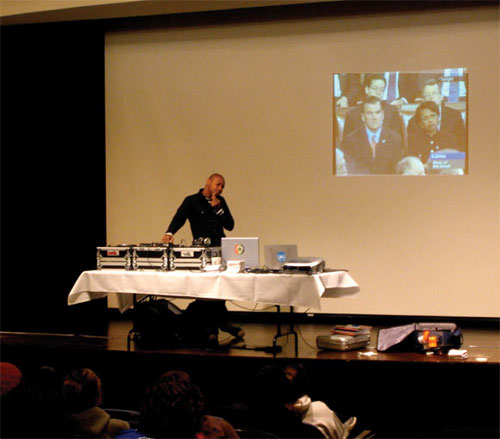DJ Spooky Remixes Digital Culture by Peter Enzminger

Miller plays a “remixed†State of the Union clip at his talk.
Image and text source: The Student Life and Life Style, Pomona College
March 24, 2006
Standing quietly behind his chrome-encased digital turn tables, Paul Miller, a.k.a. DJ Spooky, affably channels the virtues of communism into the auditory world of music creation. As do many in DJ culture, Miller composes by sampling and remixing previously existing songs and images into an audio-visual collage all his own—essentially a de-privatization of the sonic landscape. But rather than adding drum lines to borrowed melodies and claiming the product as his own (see Diddy’s “I’ll Be Missing Youâ€), Miller completely reworks his source material into a creation entirely of his own making.
“My motto is how to make art of patterns of culture,†he said at his March 6 appearance at Rose Hills Theatre, and, thanks to modern digital technology, the world is literally his playground. “The mythology of sampling and DJ culture centers around the idea of the gift economy—music is about networks and systems of exchange,†he explained. “Of course,†he added later, “the goal is to not get sued.†To date, Miller is happily lawsuit-free. He reinforced his point about the gift economy by bringing enough mix CDs of his own work for each member of the audience to keep one. He distributed three different recordings and encouraged those in attendance to mix, match, rip, and burn as they liked. In a trusting move, he also passed his personal record collection through the crowd, but these had to be returned. “Music may be a gift economy, but please, I’d like these back,†he said with a laugh.
Beyond being a published author, a credentialed academic (he has a double major in Philosophy and French Literature from Bowdoin College), and a gifted DJ, Paul Miller was a self effacing, candid speaker. He managed to convey his philosophies regarding the recontextualizing power of sampling and video editing without sounding pedantic and discussed the performative aspects of his presentation without sounding self-congratulatory. His modesty was all the more impressive considering some recent developments in his professional career—the estate of jazz legend Charlie Parker has asked him for a remix album, and at one point he let slip that The Doors, as he put it, “asked me to remix their stuff.†He shared a preliminary remix of “Soul Kitchen†in which Jim Morrison hauntingly sings several lines a capella; the rest of the song proceeds as normal, albeit grounded in a new drum beat of Spooky’s own creation.
Calling Miller’s presentation a lecture would misrepresent the scope of what was truly an exhibition of the DJ’s intellectual and technical talents. He peppered his talking points with multimedia examples and live performances. The most spectacular of these came when he mentioned his ability to remix video, as opposed to merely sound. Equipped with his turn tables, two laptops, and a projection screen, Miller cued up Jimi Hendrix’s famous live rendition of “The Star Spangled Banner†from Woodstock 1969. With seemingly effortless dexterity, he broke the clip into small samples which he selected, looped, reversed, and accelerated to rebuild into a new track. Into this fluid creation, Miller slowly introduced new elements. From the middle of a close-up of Hendrix’s guitar emerged the aggressive profile of DMX, the image growing more distinct as his guttural rap “X gon’ give it to ya†grew louder. Miller wove this one insistent DMX lyric, and its commensurately insistent drum-roll of a beat, mostly into the background, as something of a belligerent pulse to his concoction. After introducing DMX, Miller let Hendrix fade from the screen and replaced him with a clip of the Beatles performing “Paperback Writer.†Into this audiovisual soup of DMX’s barking head and shoulders and George Harrison’s muscular guitar riff, Miller added the distinctive hand-clap beat from OutKast’s “Hey Ya,†followed closely by footage from the video. For a brief while, DMX, all four Beatles, and all eight André 3000s (in the music video he plays all the members of his back-up band) occupied the same visual and auditory space, overlapping and elbowing each other while Miller fragmented and reordered them into a fresh composition. Gradually, each element faded away until André 3000 belting out “my baby don’t mess around†on infinite loop over a sparse beat was the only sound and image remaining.
Writing his own signature with the sights and sounds of what the media has to offer is clearly where Miller’s creative enthusiasm shines brightest. Another of the creations he “just did real quick†combined a commercial of British soldiers breakdancing in front of Buckingham Palace with the beat from “Still D.R.E†by Dr. Dre. Juxtaposing the changing of the guard with gangsta rap brilliantly illustrates the ability of the remix to de-center identity. As Miller succinctly described, “the remix unhinges context.†Like a dialectic of sound, the remix absorbs the connotations of its component parts in the production of a fresh creation. The power to write stories from the oversupply of information circulating in the media gives the DJ a kind of carte blanche ability to rewrite historical moments and cross-examine the cultural landscape as his or her creative impulses direct. “There are an infinite amount of permutations—anyone can take music and media anywhere, so why not remix and use existing stories to tell your own?†he asked.
Lascia un commento
You must be logged in to post a comment.








